|
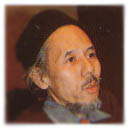 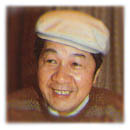 Puss 'n Boots (1969) is an anime classic whose main character Pero was so popular he became Toei Doga's mascot, and whose legendary final castle chase was the object of
an homage in Hayao Miyazaki's Castle of Cagliostro. 14 years after the making of the film, in this interview included at the end of the Animage film comic published in 1984, two of the principal staff discuss how
Puss 'n Boots came about: Animation director Yasuji Mori (1925-1992),
one of Toei's founding members and a master animator renowned for single-handledly creating the role of "animation director" in Little Prince & the 8-Headed Dragon (1963, Toei);
and key animator Yasuo Otsuka (b. 1931), who went on to be Cagliostro's animation director and is currently the head of an internet-based animation school.
Puss 'n Boots (1969) is an anime classic whose main character Pero was so popular he became Toei Doga's mascot, and whose legendary final castle chase was the object of
an homage in Hayao Miyazaki's Castle of Cagliostro. 14 years after the making of the film, in this interview included at the end of the Animage film comic published in 1984, two of the principal staff discuss how
Puss 'n Boots came about: Animation director Yasuji Mori (1925-1992),
one of Toei's founding members and a master animator renowned for single-handledly creating the role of "animation director" in Little Prince & the 8-Headed Dragon (1963, Toei);
and key animator Yasuo Otsuka (b. 1931), who went on to be Cagliostro's animation director and is currently the head of an internet-based animation school.
| In Puss 'n Boots, the storyboard became the e-konte |
Animage: First, could you explain how the movie was made, step by step?
Otsuka: The script for an animated film
is usually made by drawing a series of pictures. Often, during the process of drawing these pictures, many interesting ideas
get added and the script changes along the way. Well, that's what happened with this movie. First the director (Koro) Yabuki
drew a rough konte. Next, Yabuki and animation director Mori assigned key animators to each scene. For example, "Miyazaki
will do this one, (Yoichi) Kotabe will do this one, Otsuka will do this one..." etc.
The rough konte was divided up in this fashion.
Mori: Right. But of course all the key animators wanted to do the interesting scenes, so division of responsibility was difficult.
Otsuka: Some key animators complained that all the most interesting scenes in the film had already
been taken. "Otsuka took Lucifer's transformation, and Miyazaki took the final chase scene!"
Mori: Yes. (Sadao) Kikuchi was one of them. He did the scene during the credits where Pero walks towards Pierre's house.
But it's true. I think the ending was the most interesing part for those doing the actual animation.
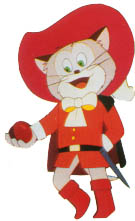 Otsuka: Once all the scenes were assigned, each key animator
then drew a storyboard, and then these got pasted up on the
walls of the Toei Doga studio. Yabuki gave these the basic look-over, saying "That's good, we'll go with that."
Next the in-betweeners copied the storyboards onto white paper using carbon-paper (because there was no Xerox
back then). Those became the e-konte. Otsuka: Once all the scenes were assigned, each key animator
then drew a storyboard, and then these got pasted up on the
walls of the Toei Doga studio. Yabuki gave these the basic look-over, saying "That's good, we'll go with that."
Next the in-betweeners copied the storyboards onto white paper using carbon-paper (because there was no Xerox
back then). Those became the e-konte.
AM: You mean to say that this movie's e-konte wasn't drawn by Yabuki, but was based on the storyboards
drawn by the key animators responsible for each scene?
Otsuka: Yes. That's why looking at the e-konte I can immediately identify which
drawings are Mori's and which are my drawings. (AM editor's note: Koro Yabuki lent me the e-konte and I brought it to this discussion)
Mori: Ah, that's right. I don't remember very well how it all happened, but looking at this e-konte, I can see that this
drawing is indeed Kotabe's, and this one's mine.
AM: That's a pretty uneven way of doing things.
Otsuka: Not really. For this film, director Yabuki took what you might call an open approach. His method
was to leave the contents to each key animator, and tie everything together, sort of in the American style.
He's not the only one who has taken that approach. In Hols, Prince of the Sun, the film we did before
Puss, Paku (Isao Takahata) precisely specified every single cut in the film, which is exactly the opposite
approach. But Yabuki's approach was interesting in its own right to the animators, since it gave us a free hand to do what we wanted.
That's why Mori's personality comes through very strongly in certain scenes, my personality comes through
in others, and Miyazaki's comes through in others.
Mori: That's true.
AM: Specifically, then, Otsuka-san, for which scenes did you draw key animation?
 Otsuka: Well, the one I mentioned before in passing, Lucifer's transformation scene - that was mine.
Yabuki also liked fan service, so he told me, "Since you're doing the next scene, let's
have a dragon in the next scene."1 (laughs) Otsuka: Well, the one I mentioned before in passing, Lucifer's transformation scene - that was mine.
Yabuki also liked fan service, so he told me, "Since you're doing the next scene, let's
have a dragon in the next scene."1 (laughs)
Mori: That dragon was good. You know, the lion, the elephant - all those animals Lucifer transforms into were created by Otsuka.
Otsuka: I kept the nuance of Mori's Lucifer in the eyes and eyebrows, but otherwise I drew them without asking
anybody else. Afterwards I showed the characters to Mori, and he OKed them.
Mori: Another scene done by Otsuka which I thought was really good was the fainting scene.
AM: Oh, you mean the scene where Princess Rosa faints after seeing Lucifer transform into a dragon.
Mori: Yes, that's the one. I watched the video for this discussion, and I was very impressed when I saw that. I thought,
"Man, what great timing."
Otsuka: I don't know... I break out in a cold sweat whenever I see that part.2
Mori: There are a lot of good parts in Miyazaki's scenes too.
AM: Which ones did Miyazaki do?
Otsuka: Miyazaki was assigned the part starting after Lucifer's skull pendant pops onto the little mouse
assassin's head, and Pero distracts Lucifer with another skull and Lucifer makes a face like, "Huh? Which is
the real one?" That's the part where the tower crumbles after Pierre and Princess Rosa have climbed up the tower.
One of his other scenes is the one where Pierre crashes through the window carrying Princess Rosa. It's very well done,
and so cool. It was around that time that Miyazaki started liking "cool" animation. But he sometimes tried to hide
that fact because it seemed to embarrass him.
AM: (laughs) And Mori's scenes?
Otsuka: You did the music scene, right? The one where Pierre and Pero go off on a journey together singing and dancing.
Mori: That part is awful. I'm so ashamed. (laughs) I had a hard time getting the skipping right. The difficult
thing about skipping is how the legs come up. That's why when I was asked to do another skipping scene for the opening
of Heidi, Girl of the Alps (1974, Zuiyo), I didn't want to screw it up again, so I filmed some people
skipping on 8mm and drew it by analyzing that.
Otsuka: If you're even slightly lacking in skill as an animator, the skipping comes out stiff. It lacks
bounce. You practically have to animate the entire thing to get it right. If the in-betweener gets the timing just
slightly off, the whole thing is ruined.
AM: How were the characters created? I know Mori is credited as the character designer.
Otsuka: Correct. First Mori read the script and drew Pierre and his brothers and Lucifer; then he drew the mouse assassins.
Then he asked everybody, "Is this OK?" to which we replied "BANZAI! Wonderful!" (laughs) and set to work drawing the storyboards.
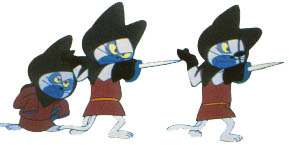 AM: Was it Mori's idea to make one of the cat assassin characters a bit 'slower' than the others? AM: Was it Mori's idea to make one of the cat assassin characters a bit 'slower' than the others?
Otsuka: No, decisions like that would have been made at the stage where we were all drawing the storyboard.
Mori: That's quite possible. All I remember about this movie is that all the characters were pretty much easily accepted
without any objections.
Otsuka: I think these characters must have been easy for you to create. Apart from Hilda from Hols, the
distinctive flavor of your work always seemed to be cute little animals like those in Kitty's Graffiti (1957, Toei).
That special waddle you give the thief mice is wonderful. That distinctive flavor is no effort because it comes naturally to you.
| A fun, carefree movie that was a breeze to make |
AM: From what I hear you two saying, it seems like there were no aspects of this movie which gave you any trouble.
Otsuka: That's exactly right. After Hols gave us so much trouble in so many ways, when it was done, the feeling
among the staff was, "We're worn out. This time let's make an easy movie that doesn't try to say anything difficult."
Puss was the movie that absorbed all those feelings. That's why to us it feels like it was a breeze to make.
Mori: Yes, ordinarily there are things about a movie I dislike having to do as the animation director, and
I have arguments with the director over different interpretations - but not with this movie. Everything
went without a hitch.
AM: That sense of unburdening may have been what made Puss a fun, carefree movie.
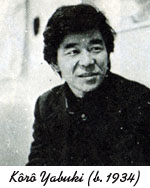 Otsuka: Yes. And the high animation quality we sought in Hols went straight into Puss, so it's
not just fun for fun's sake, it's built on solid technical know-how. Perhaps it's not for me to say this, having
been involved in the production, but I beleive the quality of the drawings in this film is very high. Even
after all these years I find the level of quality more than adequate. Otsuka: Yes. And the high animation quality we sought in Hols went straight into Puss, so it's
not just fun for fun's sake, it's built on solid technical know-how. Perhaps it's not for me to say this, having
been involved in the production, but I beleive the quality of the drawings in this film is very high. Even
after all these years I find the level of quality more than adequate.
Mori: I agree, it's really something.
Otsuka: The only problem was with character uniformity. Just look at Pierre: He started out as this
pathetic weakling of a little brother, but then he leaps onto a white horse and charges out to defeat Satan.
And when Satan transforms, he brandishes his sword without a trace of fear, full of derring-do. (laughs)
AM: No kidding! All of a sudden Pierre becomes brave. During the first half of the movie his eyes are
only half-open, but during the second half they shoot wide open. (laughs)
Otsuka: That's what happens when the
director gives the staff freedom and the key animators do whatever they want.
Mori: But I think this movie is interesting
enough that the audience doesn't notice that sort of thing.
Otsuka: Absolutely. On stricly objective
terms you could say this movie has a problem with character consistency. But the movie doesn't make you
feel there's a problem. It makes that question seem besides the point. It's just meant to be a fun,
carefree movie. This type of pure entertainment movie follows in the footsteps of Disney,
and may be a vital genre of animation.
AM: Do you feel the same way about the thematic aspects of this movie?
Otsuka: Yes, because there is basically
no theme to speak of in the case of Puss.
AM: But, you'll admit that without a specific theme, one wrong step can lead the
various staff members to go their own way, which has a chance of making a muddle of the film.
Otsuka: True. In that sense we were
lucky the movie 'came together'. But really the director is to thank for that.
Mori: Right. To make a movie with this method,
you can't hoard the creativity and tell everyone what to do; you have to be able to bring out the best
in your staff. The director's open approach was a big part of the film's success, along with the hard
work of the two assistant directors, (Tokiji)
Kaburaki and (Oibe) Yasuo.
| Japan's first animation director with Little Prince |
Otsuka: By the way, Mori...
You were the first Japanese animator to be given the title of 'animation director' with the film
Little Prince & the 8-Headed Dragon (1963, Toei),
and Puss was only your second time as animation director, wasn't it?
AM: What?! Mori was the first animation director in Japan?
Otsuka: That's right.
The animation director system became the norm after Little Prince, and it continues to
be used to this day on the production floor even for TV anime.
AM: What was the sequence of events which led to the creation of the
animation director system specifically during Little Prince?
Otsuka: To answer that, I practically first have to
tell the history of Toei Doga feature films. Ever since Hakujaden (1958), Toei Doga's
'character style' has been created by two people: Mori and (Akira) Daikubara. In Hakujaden, for example, Mori's work
was centered around the animal characters, but on the whole both had an equal part in
creating the overall  'style' of the characters and checking their movement. For the next film, Shonen Sarutobi
Sasuke (1959), the work was more centered around Daikubara. Again, Saiy#363;;ki (1960) was about half-half,
and Anju & Zushiomaru (1961) went more according to Daikubara's pace. Daikubara's work on Sinbad's
Adventures (1962) was very similar to the duties of a modern animation director, though he's not credited as
such in the film. However, Daikubara's proto-animation director approach fell more into the camp of preserving
the individuality of each animator, so it didn't bring about much uniformity; ie, (Daikichiro) Kusube's
characters were accepted as Kusube's characters, my character were accepted as my characters, and so on. 'style' of the characters and checking their movement. For the next film, Shonen Sarutobi
Sasuke (1959), the work was more centered around Daikubara. Again, Saiy#363;;ki (1960) was about half-half,
and Anju & Zushiomaru (1961) went more according to Daikubara's pace. Daikubara's work on Sinbad's
Adventures (1962) was very similar to the duties of a modern animation director, though he's not credited as
such in the film. However, Daikubara's proto-animation director approach fell more into the camp of preserving
the individuality of each animator, so it didn't bring about much uniformity; ie, (Daikichiro) Kusube's
characters were accepted as Kusube's characters, my character were accepted as my characters, and so on.
AM: Meaning there was a certain amount of discrepancy among the characters?
Otsuka: Yes. That's why the younger key animators wanted
to do a film with a more unified design for the next film, Little Prince.
AM: So Mori got chosen for the duty of unifying the characters?
Mori: Yes. But I think the strong influcene of art
director (Reiji) Koyama was another factor which
led to the creation of the job of animation director. He was the type who asserted his opinions with the director;
so when the animators saw the art director going that extra mile for the art, not wanting
to be outdone, they decided they wanted a representative to tell the director their opinions.
Otsuka: Yes, that did happen.
AM: How was your first experience as animation director?
Mori: Well, I wasn't sure what to do at first. Only... the characters
for Sinbad had been chosen from various peoples' suggestions, so no two characters had the same proportions.
On the screen that looks pretty strange. So I felt I needed to make sure there was uniformity, and that was something
I checked.
| TV animation directors have become face repairmen! |
AM: So you were asked back for a second term with Puss.
Mori: Yes.
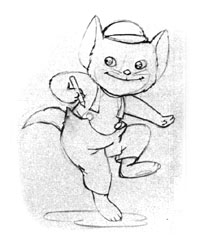 Otsuka: There was even less discrepancy in
the visual atmosphere of this movie than in Little Prince, since this time all the characters were
designed by Mori. Back then, it was expected that the animation director would create all the characters,
unlike nowadays, when the character designer and animation director are two separate people. If a drawing from a key animator
or in-betweener didn't feel right, all it took to give the character the right feeling was
for the animation director, the one who created the character, to fix a single line. Now that the two are separate,
characters can sometimes be lacking the right 'spirit'. That never used to be an issue. Otsuka: There was even less discrepancy in
the visual atmosphere of this movie than in Little Prince, since this time all the characters were
designed by Mori. Back then, it was expected that the animation director would create all the characters,
unlike nowadays, when the character designer and animation director are two separate people. If a drawing from a key animator
or in-betweener didn't feel right, all it took to give the character the right feeling was
for the animation director, the one who created the character, to fix a single line. Now that the two are separate,
characters can sometimes be lacking the right 'spirit'. That never used to be an issue.
AM: Specifically which parts of Puss did you personally handle as the animation director, Mori-san?
Mori: None of Otsuka's sections were corrected by me, I think.
Otsuka: Oh, come on. You corrected plenty of mine.
(laughs) You re-drew almost every drawing of Princess Rosa
in the movie.
Mori: The princess... yes, I corrected most of those.
(laughs)
Otsuka: He corrected all of them (laughs). Even for sub-characters like Pierre's
brothers or the castle officials, Mori's basic stance was: no tolerance for inconsistency in the characters
drawn by the key animators. When I was the animation director for Hols, I didn't correct
any of the sections drawn by Miyazaki or Mori - so looked at now, Hols's face changes so much it's embarrassing.
But in Puss that never happens. The style is uniform throughout.
Mori: Correcting one's sempais' drawings can
be hard. That's probably part of the reason why you didn't correct any of my drawings for Hols.
Otsuka: No. You're right about it being hard
to correct sempais' drawings, but in your case there was simply no need to.
Mori: Still, nowadays there seem to be more and more TV
series animation directors who do nothing but correct: professional face correctors...
Otsuka: True. Nowadays there's no
time for the animation director to meet with the director to tell him that a character wouldn't do a certain thing.
Mori: The animation director is supposed to be
there to tell the director what would be the best thing to do from an animation standpoint, but hardly
anybody does that anymore.
To be continued...
Date unknown
From: Nagagutsu wo haita neko, Animage Bunko, 1984, pp 86-106
Translated May 2001 |
NOTES
1. Otsuka animated the 8-headed dragon in the battle scene which occupies the last 10 minutes of
the 1963 film Little Prince & the 8-Headed Dragon, hence the director's comment.
2. Cold Sweat: Hiya Ase. In the introduction to the revised edition of Otsuka's book Sakuga Ase
Mamire (Cels Covered in Sweat) which was published in May 2001, Otsuka jokes that he half wanted to rename the book Sakuga Hiya Ase Darake (Cels Covered in Cold Sweat).
| 
